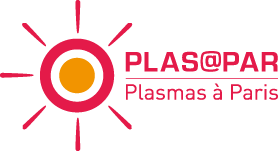
Reconnection, shocks and instabilities: energy conversion in a plasma
- Laboratories: LPP, LERMA, IAP, LATMOS, LULI
- Number of researchers involved: about 30
- Publications (2012-2018): more than 200
This theme concerns all the energy conversion mechanisms in plasmas: shocks and instabilities, but also reconnection, and particle acceleration and the magnetic dynamo. These fundamental processes are universal for all plasmas and often cause turbulence. Again, the multi-scale and highly nonlinear behavior is a major obstacle to their understanding. And their universality - from laboratory and industrial plasmas, to space and astrophysical plasmas - places them at the heart of fundamental and / or applied research.
Indeed, these mechanisms will receive direct lighting via data from the most recent space missions (THEMIS, MMS, Parker Solar Probe) and to come (Bepi Colombo, Solar Orbiter, Juice, JWST ...), but also by telescope observation (CTA and ALMA), or laboratory experiments on new generation laser installations (LMJ / PETAL, APOLLON and ELI), installations and missions in which some laboratories of PLAS@PAR are strongly involved.
These mechanisms also play a central role in high energy astrophysics as they drive the production of high energy particles in the Universe.
In addition, another important aspect of this theme concerns numerical simulation through the development of simulation codes that have integrated algorithms for massively parallel machines among the most advanced today: the SMILEI (Simulating Matter Irradiated by Light at Extreme Intensities) and PHARE (Parallel Hybrid Code with Adaptive mesh REfinement) codes still under development.
These codes will be an asset to answer many questions:
-
What are the basic microscopic mechanisms of magnetic reconnection and how does the transformation of magnetic energy into kinetic and thermal energy occur?
-
How do instabilities intervene in energy exchanges?
-
How to study in numerical simulations the process of particle acceleration, and the effects of instabilities and radiation in shocks, on realistic spatio-temporal scales for comparison with spatial observations?
These problems are fundamentally linked to the codes used to describe plasmas because today even the most efficient computers cannot solve all the scales involved at the same time. Moreover, it is important to design laboratory experiments that help us to solve these questions through the comparison of numerical and experimental results.
ILLUSTRATION: Phase spaces of the magnetized Weibel instability: it represents the evolution in the non-linear phase of the electron momentum phase space for a single unstable mode of the filamentation instability in the presence of an external flow-aligned magnetic field. Code PIC SMILEI, used by a large part of the community (LULI, LPP, LERMA, LATMOS, IAP). © Anna Grassi, LULI.
